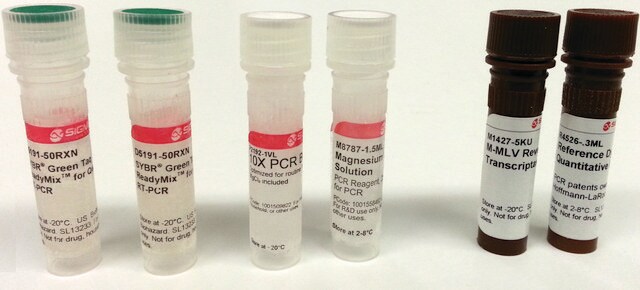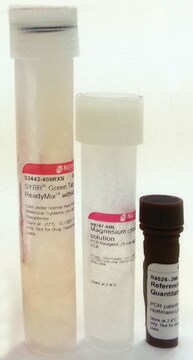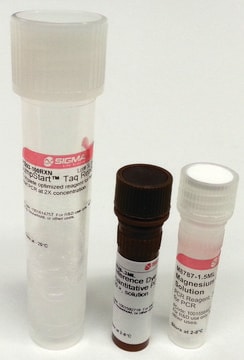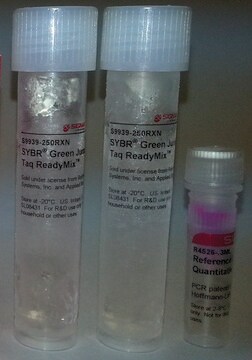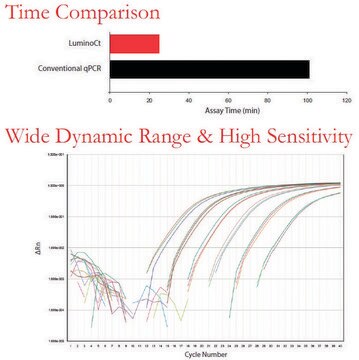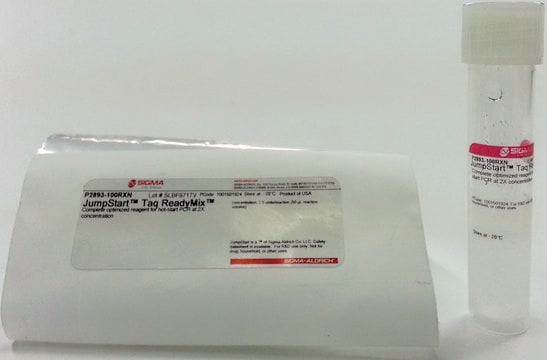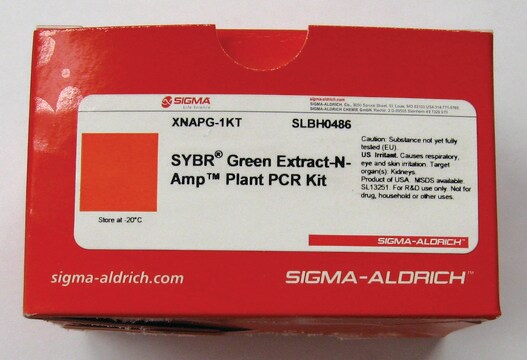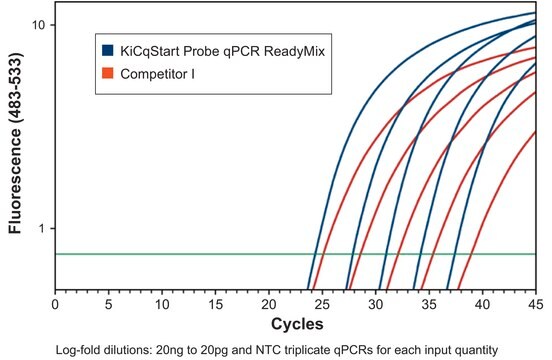R4526
Reference Dye for Quantitative PCR
100 ×, solution
Synonym(s):
Reference dye for qPCR, ROX
Sign Into View Organizational & Contract Pricing
All Photos(1)
About This Item
UNSPSC Code:
41106300
NACRES:
NA.55
Recommended Products
form
solution
Quality Level
usage
sufficient for ≥600 reactions
concentration
100 ×
technique(s)
PCR: suitable
color
red
solubility
water: soluble
storage temp.
2-8°C
Related Categories
General description
Sigma′s Reference Dye for quantitative polymerase chain reaction (qPCR) is a proprietary dye for use with real-time PCR. It is used for the normalization of reaction data when using SYBR Green, molecular probes, or dual-labeled probe chemistries for real-time detection. The Reference Dye is supplied as a 100× solution with a maximum excitation and emission of 586 nm and 605 nm, respectively. Instrument settings for ROX reference dye are satisfactory for the measurement of Reference Dye for qPCR.
Application
Reference Dye for Quantitative PCR has been used:
- in the preparation of mastermix for real time-quantitative polymerase chain reaction (RT-qPCR)
- as a component of the reaction mixture for detection of Clostridium difficile by quantitative polymerase chain reaction (qPCR)
- for analyzing the degree of cellular DNA contamination by qPCR
Other Notes
Reference Dye for Quantitative PCR is forR&D use only. Not for drug, household, or other uses.
signalword
Warning
hcodes
Hazard Classifications
Aquatic Acute 1 - Aquatic Chronic 1 - Eye Irrit. 2 - Skin Irrit. 2 - Skin Sens. 1
Storage Class
12 - Non Combustible Liquids
wgk_germany
WGK 3
flash_point_f
Not applicable
flash_point_c
Not applicable
ppe
Eyeshields, Gloves
Choose from one of the most recent versions:
Already Own This Product?
Find documentation for the products that you have recently purchased in the Document Library.
Customers Also Viewed
Increased environmental sample area and recovery of Clostridium difficile spores from hospital surfaces by quantitative PCR and enrichment culture
Brown KA, et al.
Infection Control and Hospital Epidemiology : The Official Journal of the Society of Hospital Epidemiologists of America, 39(8), 917-923 (2018)
Partial deletion of rng (RNase G)-enhanced homoethanol fermentation of xylose by the non-transgenic Escherichia coli RM10
Manow R, et al.
Journal of Industrial Microbiology & Biotechnology, 39(7), 977-985 (2012)
Sambrook, J. et al.
Molecular Cloning: A Laboratory Manual, 3rd (2000)
Araceli Melendez-Avalos et al.
Folia microbiologica, 65(1), 133-142 (2019-05-20)
This study aimed to analyze the proinflammatory cytokine mRNA expression in the urinary tract of BALB/c mice infected with bacterial strains with uropathogenic potential. Groups of four 6-week-old female BALB/c mice were intraurethrally inoculated with 5 × 107 colony-forming units (CFU) of
Gustav Johansson et al.
Molecular cancer therapeutics, 20(12), 2568-2576 (2021-09-24)
The majority of patients diagnosed with advanced gastrointestinal stromal tumors (GISTs) are successfully treated with a combination of surgery and tyrosine kinase inhibitors (TKIs). However, it remains challenging to monitor treatment efficacy and identify relapse early. Here, we utilized a
Protocols
Our SYBR Green qPCR Protocol is a method designed to detect accurate quantification of gene expression and RT-PCR reactions
Our team of scientists has experience in all areas of research including Life Science, Material Science, Chemical Synthesis, Chromatography, Analytical and many others.
Contact Technical Service